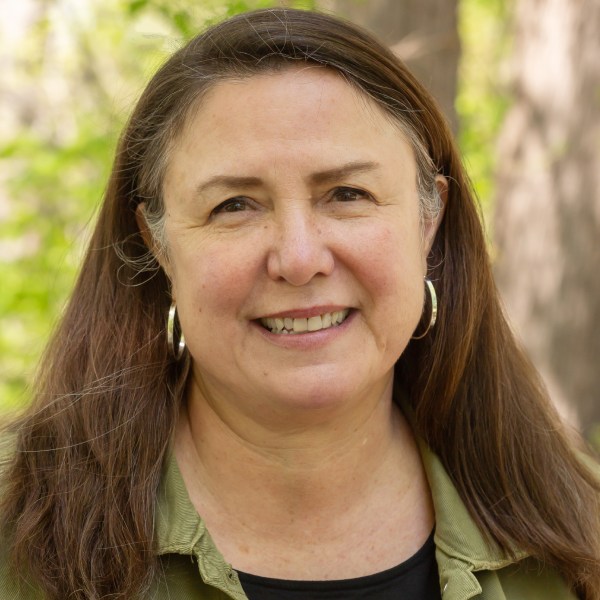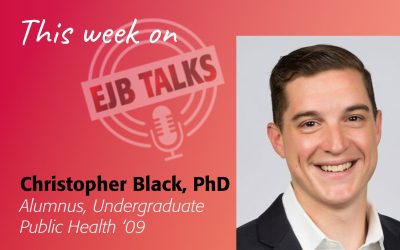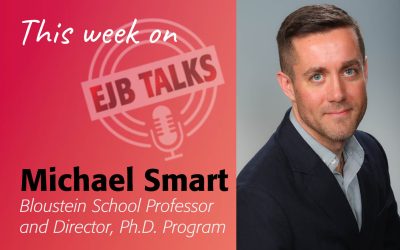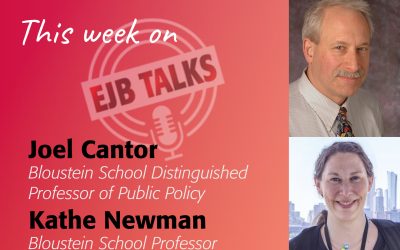EJB Talks welcomes Jeanne Herb, executive director of the Bloustein School’s Environmental Analysis and Communications Group to talk about the intersection of the climate crisis, COVID, and economic inequality with Stuart Shapiro. They discuss the work that her center and Rutgers University are doing to help New Jersey address the disparate impacts of climate change on our most vulnerable populations, and how no longer viewing climate change as separate from our other crises may allow us to write and implement effective policy solutions.
Stuart Shapiro
Welcome to another episode of EJB talks. I’m Stuart Shapiro, the Associate Dean of Faculty at the Bloustein School, and the purpose of this podcast is to talk with my colleagues and our alumni about issues affecting people in New Jersey, the United States in the world. Because three crises–COVID, the recession, and racial injustice is never enough–today, we’ve decided to add in climate change. The Bloustein School covers climate change from a wide variety of perspectives. Today, I’m very lucky to be speaking with Jeanne Herb, the Executive Director of our Environmental Analysis and Communications Group, who also co-directs the New Jersey Climate Change Resource Center at Rutgers University. Jeanne, thanks so much for joining us.
Jeanne Herb
Well, thanks so much for having me. I’m really happy to be here.
Stuart Shapiro
Wonderful. Can you tell us a little bit about what the Environmental Analysis and Communications Group is and does?
Jeanne Herb
Yes, so our little group, the Environmental Analysis and Communications Group, which is EAC pronounced eeek. (laughing). It’s a very unfortunate acronym, is one of the research centers here at the Bloustein School. I think of it as a center of research and practice because our work is very applied. We collaborate with partners from inside and outside the university to conduct research, to do stakeholder engagement,and public policy analysis. Our projects generate data and knowledge and best practices that can support development of informed strategies that relate to environmental sustainability, and the intersection of health with other sectors. At any given time we might be supporting development of tools that help state and local decision-makers plan for changing climate conditions, or that avoid conflicts with the use of natural resources. We conduct analysis that identifies areas of disproportionate environmental burden. We’ve worked on assessing health outcomes and energy policy decisions. We’re currently involved in supporting work in one county and developing their hazard mitigation plan that will incorporate future climate conditions. So our work is really very diverse.
Stuart Shapiro
And it really sort of touches on the fact that climate change touches everything.
Jeanne Herb
Correct.
Stuart Shapiro
You’ve made the argument, for example, that rather than climate change being a fourth separate crisis from the other ones that we’re undergoing as a nation right now, that it interacts…climate change interacts closely with the other crises I mentioned. Can you elaborate on this argument?
Jeanne Herb
I’m happy to do that. One of the hats that I wear here at the Bloustein School is I co-direct a new center. It’s called the New Jersey Climate Change Resource Center, which is a service center of sorts that was established by a law signed by Governor Murphy just this past January. The mission of the center is to work collaboratively with other academics partners to bring science and evidence to support efforts in government, in the private sector, in communities, and in nonprofit groups to address climate change. Just two weeks ago, we held a two-part virtual convening, and it was titled, “Rebuilding New Jersey After COVID. Advancing a Healthy, Resilient, Sustainable and Fair Garden State.”
We had panelists in three panels and they pointed to these three intersecting crisis. The immediate crisis of COVID, along with its associated economic depression, that will unequally affect the same populations that were hit hardest by the virus. The centuries-old crisis of structural racism that prevents people of color from having access to the same economic-environmental-social conditions as their white counterparts. And the climate crisis, which has been building for more than a decade, or more than a century, and is having disproportionate impacts on various certain populations and communities including low income populations, communities of color immigrants, children, older residents, people with disabilities, and pre-existing health conditions.
The populations in the communities that face unequal access to conditions that support health and well being face multiple social, physical, and economic stresses. So some of the things that we heard, as part of the panel that we had, the panelists talked about how the COVID pandemic has drawn attention to the multiple stressors that the populations hit hardest by the virus have to face every day. Black people, who make up 14% of New Jersey’s population, account for more than 17% of the COVID cases, and almost 19% of the deaths. Black New Jerseyans are more likely to die from 8 of the 10 leading causes of death in New Jersey. And high school graduation rates in New Jersey for Black and Hispanic students is 83 and 84%, compared to 95 and 97% for White and Asian counterparts. We can go on and on in terms of some of the statistics regarding median income or graduation rates. We can go on and on. But some of the other things that our panelists talked about is that 50 …Well, actually some of the work that we’ve done in our little EAC center is that 59% and 97% of low income, high minority census tracts are located in the hundred year floodplain. So when we did this kind of analysis, what we did was we found that there’s 160 census tracts in New Jersey that have 25% or greater distribution of environmental factors per square mile. And those…Yes, it’s really kind of stunning. And we find that those have a majority, almost 94% of those tracks were identified as being low income and high minority. 94%! Fifty nine of those 94%, and 97 of those tracks are in the hundred year floodplain and next to major roadways. So we can see how these multiple stressors affect the same populations.
There was a lot of attention to a recent Harvard University School of Public Health study that found that people with COVID who live in U.S. regions with high levels of air pollution are more likely to die from the virus than people who live in less polluted areas. And all of that, all of those multiple stressors, whether it’s stressors regarding lack of access to a good education, or a living-wage job, or living near polluting sources, or being disproportionately affected by climate impacts. All of those become evident when you look at some of the statistics that one of our panelists talked about, that a black child today born in Trenton has a life expectancy of 73 years, compared to a white child born in Princeton Junction with an average life expectancy of 87 years. So we can start to see how these multiple stressors really in intersect and cause a cumulative burden on certain populations.
Stuart Shapiro
So with that data on living in a floodplain? How…you know, I understand sort of intuitively why a hazardous waste facility is in a poor neighborhood. That’s going to be the people that can’t protest it, that’s going to be the place that you’re going to be more likely to put that as a result. But the floodplain data, doesn’t strike me as intuitive. Do you have any sort of reasoning as to why these populations are so much more likely to live in areas that are going to be affected by climate change?
Jeanne Herb
Well, I think what we’ve certainly seen is a lack of participation in decision-making that many of the same… this is where some of the concepts of climate justice come in. That some of the same populations that are most affected by changing climate conditions have the least amount of say in the decisions that allow them to protect themselves from changing climate conditions. And so, I think that sort of goes hand in hand with your question as to, who’s living in harm’s way. I think in addition to who’s living in harm’s way, the other issue that we spend–we meaning the Bloustein School team, but also folks throughout the University–look at is the inherent vulnerability of certain populations because of the conditions that they may live in or be exposed to. Certainly some populations have some vulnerability because of age or disability. But, other populations are more vulnerable to climate conditions because of underlying social inequity.
So think about it this way. Here’s some examples that we heard as part of talking to residents and leaders in a recent project that we just finished up. If my community is experiencing a flood event, regardless of whether it’s tidal nuisance flooding, or flooding from an extreme weather event. People… everyone is gonna have a hard time getting to work, right?
Stuart Shapiro
Yes.
Jeanne Herb
But if I’m someone like me, and I have the opportunity to telecommute, or get a ride somehow, then that’s great. But that’s very different than other members of our community who may have an hourly wage job. And if they don’t go to work, they don’t get paid.
Stuart Shapiro
Right.
Jeanne Herb
Say my community loses power. This is the story that we heard in Long Branch. Say my community loses power due to an extreme weather event. Some people, like me, will be inconvenienced. But I might have a generator, right? Or I have the resources to buy fresh food when the power comes back on. But for other families, they don’t have those resources. And they don’t have that generator. And as a result, they have no choice but to eat spoiled food. And so when we think about some of the impacts from climate change, we certainly see that increases in water and food-borne diseases are certainly on the impacts that we’re expecting to see here in New Jersey. Just one more example. Any of us with asthma, mild asthma or more chronic asthma, may see that asthma or are likely to see that asthma worsen as ground level ozone here in New Jersey increases due to rising temperatures. But for people like me, who have great health insurance, I can get myself in a car, I can get myself to a doctor and make sure that my asthma stays in check. But that’s really different than other families, or other individuals, who don’t have access to health insurance or transportation. So that they cannot get themselves to a doctor, they cannot get the care that they need. And what we start to see then is that their asthma becomes an emergency as opposed to a managed condition.
Stuart Shapiro
That makes a lot of sense. So we’re a policy and a planning school. What are the implications of this disparate impact for thinking about policy and planning regarding climate change?
Jeanne Herb
Well, that’s a great question. In fact, there’s a lot of implications for climate change policy. Just two weeks ago, several Rutgers colleagues and I finished a really large project with the State Department of Environmental Protection. And the focus of that project was to look at, what are some policy options, some guidance, and some decision support tools that can more systematically incorporate and integrate the most vulnerable populations into climate planning in New Jersey. Last year, along with the Rutgers Climate Institute, we worked together to finish another very large project where we looked at work in 13 states and two cities to integrate equity in climate emissions policies. There’s a lot of similarities that came out of both of those projects in terms of policy implications. But I’ll just mention three of them.
One, in both projects, we learned that people and communities that are most affected by climate change, don’t have a seat at the table or the political power to affect the decisions that impact their lives every day. When you think about it though, changing policy, and the process that makes policy to reflect equity, diversity and inclusion, is a massive overhaul of how traditional policymaking works. You and I both, Stuart, have both been in government and we know what traditional stakeholder engagement looks like in a government context. And it’s not really one that reflects equity, diversity, and inclusion. So just the process itself, changing that process, is a massive policy shift.
Second, we’ve learned from both of these projects, that just building more seats at the table or building a bigger table, that more inclusion is not enough. What we learned is that underlying social inequities–that’s some of the things that we’ve talked about, right? Underinvestment in communities, lack of access to conditions that support healthy living, racism. These underlying social inequities are the biggest challenge to protecting the populations that are most vulnerable to climate change. Regardless of whether its climate impacts or the sources of pollution that caused climate change. What we learned is that we need to go beyond more inclusive processes. And we need to structure ways in which all of us become responsible for the needs of the most vulnerable populations in our communities. And one way to do that is to proactively assess the impacts of our climate decisions and our climate policies before we make them. Because if we can assess how those decisions–whether that’s moving people out of floodplain areas, building sea walls, creating new jobs in the clean energy economy–regardless of what the policy is, if we can assess how those decisions are going to impact the most vulnerable populations before we make them, we can take the time to mitigate those policies so that they are positive for the most vulnerable populations.
And my third example, is that because underlying social inequities are the biggest challenge, or one of the biggest challenges to community resilience, what we’ve come to see from these couple of projects that we’ve been involved in, is that climate policymaking needs to not just be thought of as this kind of tree hugging exercise. It needs to be multisector, it needs to be transformative. Because what we’re doing is we’re looking at ways to connect climate policy to housing, to transportation, to community development. We need to think about where our public investments in infrastructure and workforce development are being made, so that they can not only deliver clean, resilient, efficient communities and homes, but that they’re creating jobs with living wages for our most vulnerable populations. And finally, we all need to commit to the concept that climate policy is this tremendous opportunity. It’s an opportunity to address the pre-existing social, environmental, physical, and economic challenges that vulnerable populations face that really preclude them from being resilient to climate impacts.
Stuart Shapiro
So that leads, very naturally, to my next question. I mean, a lot of the things you talked about were process-oriented. Participation, doing good analysis, which was of course, music to my ears (laughing) and thinking about some of the broader impacts and connections here. In terms of substance, the Green New Deal kind of sells itself, as doing that. Is that the way you see it? I mean, it really does try to connect many of these other issues to climate change.
Jeanne Herb
Yes, I think there’s definitely similarities between these ideas and the design of the Green New Deal. And in fact, there’s this wave of economists, academic experts, some of whom are here at the university, and activists that, for the last couple months, have been encouraging Congress to advance a “green stimulus initiative” as part of national COVID recovery efforts. And that sort of wave of people are calling for financial commitments and long-term recovery packages that will create living wage jobs for the populations that are most affected by COVID. But living wage jobs that are tied to a clean energy economy and tied to climate adaptation.
They’re calling for investments in creating efficient and resilient communities. Efficient and resiliant housing and transportation systems, increasing mobility for populations most affected by climate, and ensuring safe, affordable, clean, efficient, resilient homes. And they’re also calling for commitments to ensure that all people have access to the conditions that allow them to live the healthiest life possible. Which is much more than just being able to get to a doctor, right? It’s making sure that we’re living in communities that are not overly burdened by pollution, and that we’re living in homes that are safe and clean. And so those concepts are definitely tied to this, these proponents for green stimulus tied to COVID recovery. And we’re seeing that in in Europe as well. And we’re seeing some of that conversation here in New Jersey too.
Stuart Shapiro
So let me finish by playing devil’s advocate for a moment here, as clearly these synergies that you’ve outlined between climate change and all of the other things we’re going through right now. But there’s also the fear that COVID, the recession, the protests, are going to push climate change to the back burner. There’s going to be the argument that we can’t deal with climate change right now, because we have these other things we have to deal with, particularly the economy. And, what I think is going to be a prolonged and rather deep recession. Do you have hope that this message can shine through, the dealing with climate change as part of dealing with these other crises?
Jeanne Herb
Well, yes, and I know that there’s a little bit of a tendency right now in our country to try to look at everything through a COVID-lens. But I don’t think that the motivation behind educating people about the connections between climate change, equity, and COVID are trying to push forward climate change in spite of these other crises. Rather, we’ve been well aware of the disproportionate impacts that climate change has on certain populations. And that’s been our work for a good decade. At the recent convening that we had, the panelists actually talked about the issue that you brought up. And one of the things that they kind of all sort of concluded, I guess, is that these three crises are not new. None of them are new. But have, until now, been viewed as separate challenges. And when we asked our panelists whether they were optimistic about the future despite some very sobering data and statistics that they brought in regarding the economy and inequities in society, what we heard from them is that, they really expressed hope. And so I have to share their hope. The hope that today’s increased consciousness about the intersection of this crisis is exactly the opportunity to step forward to address them.
We also had…I help to co-facilitate the New Jersey Climate Change Alliance. And just exactly this time last year, we had a convening that brought in about 75 leaders here in New Jersey. And that was on the topic of health inequity, specifically in climate change. And at that convening, we heard the message that intersecting climate change with health equity goals generates outcomes that create a society that’s not only healthier, more resilient, environmentally sustainable, but a society that’s just, in which opportunities are available to all and risks are equally shared. So I think to answer your question, I think the motivation for people trying to educate others about the connection of these deep, deep crises, is that if we look at the intersection of them, it points to the benefits that comes from addressing them together and head on.
Stuart Shapiro
Wonderful. Well, it’s not all bad off, and I get to end on a positive note here. (laughing) I’m going to call it a wrap there. Thank you so much for coming on.
Jeanne Herb
Thank you so much. Thanks, Stuart. Thanks, Amy. Take care.
Stuart Shapiro
Let me give a big thank you to our production team, as I always do, Tamara Swedberg, Amy Cobb, and Karyn Olsen. We’ll be back next week with another talk from another expert from the Bloustein School. Until then, stay safe.




